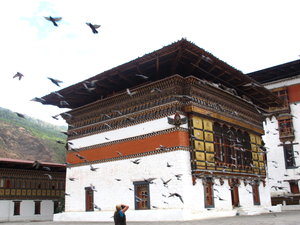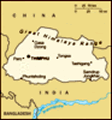Advertisement
Published: December 17th 2011

 A Newfound Tranquility
A Newfound Tranquility
Traveling in chilly 3 degree Celsius clime ain't easy for this old hag from the tropics. Plus the elevation hits me like one needs a boulder on her head. But Bhutan has this effect on us. I would have thought I stepped into my own imagination. My own dream. This trip to Bhutan is so markedly off the usual, beaten paths. Not being melodramatic, but Bhutan is truly one fairyland. Men and women in local costumes, dogs blending in with the locals like they are members of the small Bhutanese populace (they are still under 1 Million as of this writing), mountain views and bubbling streams, a culture so unique, a very strong national identity.
Dzongs as Fortresses and Monasteries
White monoliths dominate the landscape. Like castles. Some on dry, dead mountains. Others at the junction of flowing rivers. We have been to three dzongs, but managed to explore only 2. We regret having missed exploring the interiors of the
Paro Dzong (Rinpung Dzong) as we were dead tired after that climb to the
Taktshang Monastery. Besides, it was quite late and getting chilly by the time we were on our way back from Paro to our hotel in Thimpu. We can only surmise how much finer Bhutanese architecture is in this Dzong, after having seen and admired Thimpu and Punakha Dzongs. Perhaps, we can only take excitement in small doses and we

 Paro Dzong
Paro Dzong
Said to house the finest Bhutanese architecture. Dzongs are fortresses cum monasteries where religion and state rule the kingdom. Amazing!were spared from having our senses assaulted by so much beauty? I am told the movie Little Buddha was filmed here. I know I just need to watch it.
The very first Dzong we visited was the one in Thimpu, where the present (5th) monarch was crowned. Willow trees line the roads to
Trashi Chhoe Dzong which literally means "Fortress of the Glorious Religion". Both monks and state officials are housed in this Dzong where the King likewise holds office and a Throne Room. The dzong was damaged by fire and earthquakes in the past but rebuilt in traditional fashion. By that, Bhutanese mean
"without nails nor written plans". Modern-day architects with their blueprints have no place in this society.
We were so awed by this 17th century fortress with all its intricately handpainted window frames and woodcarvings. As we scaled a set of wooden stairs leading to the inner courtyard, we fell into a silence that could only mean one thing. Magic. Dreamland. Unbelievable. It helped that we were nearly the only ones in the courtyard on that chilly afternoon. Took a full 20 minutes to admire the vastness and uniqueness of the architecture. It helped

 Thimpu Dzong
Thimpu Dzong
This is where the King holds office. His Throne Room is also here. In the monastic quarter is the Monastery. All under one roof. that the community of resident pigeons flew over our heads several times as the wind spun the prayer wheels to the now familiar dong dong chime so gloriously out of a storybook.
Bhutan. And it was only our first day! And we were just in the dochey or courtyard. By the time we entered one of the temples or Lha Khangs and viewed the thousand mini-Buddhas, we were completely bowled over. Thangkas of the Buddhas of Wisdom, Longevity and Compassion hanging by the walls in between the statues of more Buddhas including Guru Rimpoche and their consorts. As we stepped out and down the Lha Khang, we found a couple of monks chatting time away. One was busily fingering a text message on his cellphone while the other looks on, yawning away. Yes, the irony. After all, these are young men like most others too. Yet it does not take away much from their pious character and polite demeanor.
On our 3rd day, we visited the
2nd of Bhutan's dzongs in Punakha, the Palace of Great Happiness. Climate is milder here which served as the seat of Bhutanese government when Punakha was still the

 Punakha Dzong
Punakha Dzong
Built at the confluence of 2 rivers: the Mother and Father Rivers of Bhutan, right there on the "trunk" of the Elephant Hill. The 1st King was crowned here.capital up until the 2nd king. Our Tour guide Sonam Norbu narrated how the construction of this 17th century dzong was foretold by Guru Rimpoche, the 2nd Buddha. Built right at the confluence of two rivers, the Mo (Mother) and Pho (Father) Chhu. Right across the dzong and the 2 rivers is a mini-park cum picnic camp where one is given the entire view of this magnificent structure.
We crossed a bridge adorned with prayer flags over the rivers and entered upon a heavy wooden door. Passing more willow trees and cherry blossoms, we scaled the steep stairs designed to be pulled up "in case of an invasion". We entered the first courtyard and found some of the 600 monks housed in this Monastery spinning their prayer wheels and chanting their mantras as logs crackle in the nearby bonfire set up in the middle of the courtyard. The "chime" music blends beautifully with the murmurs of the wind, the flutter of flying pigeons above us, that we had to pinch ourselves that this is truly happening.
The corridors beneath handpainted eaves and intricately-carved wooden panels spill into a second courtyard in the monastic quarter

 Changang Lha Khang Temple
Changang Lha Khang Temple
Gho-clad and rubber shoes-shod happy boys in this monastic school in Thimpu. Just a small one, perched on a promontory overlooking the capital city.where we entered one of the Lha Khangs or Temples. Inside, we found magnificent thangkas hanging on the walls along with the golden statues of the Buddha and Guru Rimpoche in the Main Assembly Hall where the first king was crowned. If I am not mistaken, this is also where the present (5th) King married his Queen last October 13, 2011?
Sonam Norbu, my guide, my son, where are you? Please do correct your old mother if she's wrong! Lha Khangs and Chortens
Right within Thimpu, the capital, is a
Memorial Chorten built in 1974 in memory of the 3rd king, Jigme Dorji Wangchuck. At night, it is very visible as it is illuminated. Designed like a large Tibetan-style chorten, many locals visit and do their rounds chanting their mantras as it is the focus of their daily worship. Though it is a
National Library, this unique structure houses many ancient Dzongkha and Tibetan holy books. As such, altars are set up on each floor of the library. Locals circumambulate the building while chanting their mantras because of these holy books. It is almost insignificant to mention that the National Library also houses the biggest book, and

 Zilukha Nunnery
Zilukha Nunnery
Toddler-Nuns? Our guide explained that impoverished families leave their daughters to be cared for here, growing up as nuns. He said this without a hint of pity, and with a lot of pride. is hemmed in by a 9-hole golf course. 😊
Changangkha Lhakhang may not seem much to many tourists but we are so pleased our Tour Guide brought us here. It wasn't in my list of must-see destinations, but Sonam Norbu decided we should visit it. Perched on a ridge overlooking the capital city, we met our gho-clad and kira-clad Bhutanese children in this 12th century monastic school. Our arms ached spinning the giant prayer wheels inside. I suspect this must be a favorite Lha Khang of my "adopted Bhutanese son" cum tour guide.
Last but not least, there is
Zilukha Nunnery. We climbed a dirt path from a promontory overlooking Thimpu Dzong to reach the tiny nunnery. We were allowed just 2 photos. Just a small temple where Buddha statues are housed, just a narrow strip where nuns sit crosslegged chanting their mantras and spinning their prayer wheels. Beside the small building is a similarly-sized sleeping quarters. Charming with its handpainted window frames as with most other Bhutanese houses, but definitely needing more room and higher level of comfort. The nuns had "toddler-nuns" with them. When asked, Norbu told me that impoverished families sometimes

 A Glimpse of Taktshang From Lookout Point
A Glimpse of Taktshang From Lookout Point
spin the prayer wheels for energy, patience and persistence. join the local pilgrims as they make their way to Tiger's Nest......some with toddlers on their backs, others with sleeping babies in their arms. How do they do that?????leave their children to be cared for here to grow up as nuns. He said this without a tinge of pity, perhaps even with an element of pride. What a unique culture, indeed.
Of all the religious temples and shrines we visited,
Taktshang Goemba or Tiger's Nest Monastery holds a special place in my heart. Perched precariously on a cliff some 900 meters above the Paro Valley (should render it at an elevation of over 3,000 meters or 10,000 feet), it tested not just my physical strength but more my mental resolve and virtues of persistence and patience. If only for that, I will dedicate a separate blog to my Taktshang Adventure. After all, it took me one hour on an uphill climb on a horse, another hour or so on foot to reach the last lookout to the Monastery across a deep abyss, and a full 2 hours of climbing up and down to reach the Halfway Station before the final one hour hike down to base. All of 5 hours. Phew!
Scroll all the way down for more photos...........and do check out my earlier
blog and next
blog .
Advertisement
Tot: 0.102s; Tpl: 0.016s; cc: 13; qc: 30; dbt: 0.0394s; 1; m:domysql w:travelblog (10.17.0.13); sld: 1;
; mem: 1.2mb























The Pinoy Explorer
non-member comment
Impressive!
I love the way you have narrated this part! I have some problems with the pronunciation of those temple names, but I fully appreciate it the fact that I seem to been transported in this place.